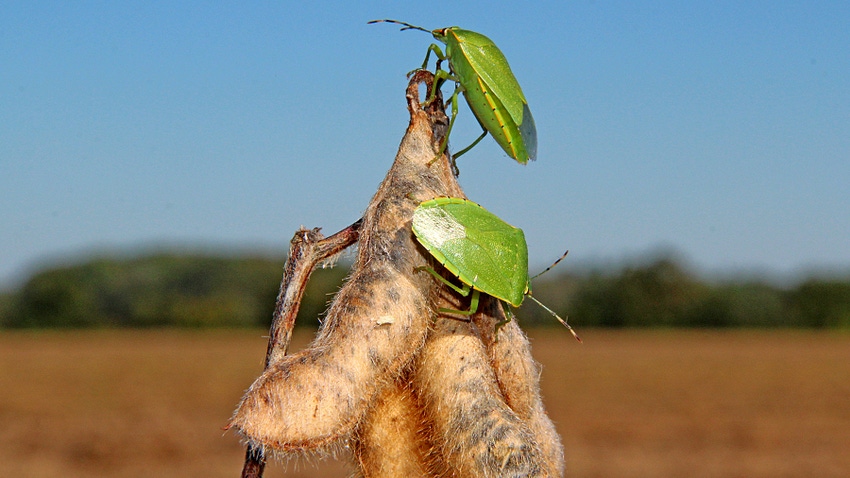
If you see a Midsouth farmer wandering along the road this season, odds are his car didn’t strand him and he’s probably not headed home from the bar now that Mardi Gras has ended. More likely, he’s searching for stinkbugs – and if so, he definitely has probable cause.
Data collected in Mississippi in 2022 shows stinkbugs infested over 2.1 million acres of soybeans across the state, with estimated bushel lost topping 3.9 million. The overall loss plus cost to spray means farmers shelled out over $79 million to the southern pests.
With soybeans covering significant acreage across Mississippi, Louisiana and Arkansas, seeking out and stymying their efforts in soy sabotage has become paramount season after season.
“For us in Louisiana, our main pest concern is in our soybeans, because our largest acreage is our soybean acreage,” said Louisiana State University soybean integrated pest management specialist Jeff Davis. “For us in 2023 it was stinkbugs and primarily the red banded stinkbug.”
Eyes on non-native stinkbugs in 2024
Native stinkbug species, particularly green and brown varieties caused roughly 38% of the total stinkbug pest impact on Mississippi crops in 2022, while the red banded stinkbug was responsible for 40% of the total crop impact on its own.
Red banded stink bugs cause the most impacts partially because of their devotion to solely feeding on legumes, which makes soybeans a prime target. Additionally, red banded stinkbugs make their stake in farmers crops early and then endure for a season-long siege.
“Other stink bugs, they'll go to corn or they'll go to cotton while the red-banded stinkbug only feeds on legumes,” Davis said. “It goes right away from clovers, like crimson clover or white clover, they're going to come from those and go directly into your soybean fields as soon as those beans come up out of the ground.”
In addition to in-field staying power, red banded stinkbugs are equipped to create more damage to soy seeds thanks to a specialized enzyme that allows them to puncture deeper into the seed, which accounts for a significant portion of the overall bushel loss. However, there is hope for significantly less loss in 2024.
“Our non-native species like our red banded stinkbug are neotropical species, so it likes the heat,” Davis said. “If we get to a certain point below 23 degrees Fahrenheit, research my lab has done shows that after about seven hours of cold, up to 50% of the population could be killed.”
After nine hours of low temperatures, up to 90% of the population could be killed. Weather reports from parts of northern Louisiana like Shreveport and Monroe experienced conditions over the winter that could have greatly reduced red banded stinkbug populations, even considering the possibility of bugs taking shelter.
“In the middle part of the state we saw a little less cold, I think those populations will be mainly affected from the drought and the heat from the previous year,” Davis said. “South and below, we didn't get as many hours of that like killing cold. Red banded stinkbugs will probably not be affected at all.”
Pest load reduced in 2023
In 2023 heat and continued drought caused profound impacts on insects. Because stinkbugs’ body temperatures mirror the ambient temperature, the only way for them to cool is to seek shelter. Without heavy canopy cover to provide shade, the insects’ populations and overall reproduction greatly declined.
“We did not spray as much in 2023, I think in part because of the heat,” Davis said. “Drought also has an impact because those plants were stressed. In what seeds if they did produce, on our dryland acres there wasn't a lot of stinkbug damage, just because in general, there weren't a lot of things for those insects to be feeding on during that drought period.”
Even in years with a reduced need for insecticide, Davis said rotating chemistries is important for complete control and reducing risk of resistance.
“For stinkbugs all we have are acephate, neonicotinoids or pyrethroids and if we lose any one of those two to resistance, we're going to have a problem controlling stink bugs,” Davis said. “We always are interested in making sure we still have products that we can use to control insects for our growers.”
Check clovers and covers
While roadsides may seem like an odd place to start crop scouting, Davis said ditches are his first place to check for stinkbugs in spring.
“Here in Louisiana, we have also crimson clover, our Department of Transportation plants all along the roadsides,” Davisa said. “That's our first place where we go to scout for our stinkbugs is those clovers and your cover crops.”
In cover crops especially, finding and identifying stinkbugs early can help producers gain perspective on the overall insect threat they will face during the growing season.
“February is going to be a little warmer and we're going to have active growth going on, especially since we’ve had rainfall,” Davis said. “Our cover crops are really going to be jumping up and those clovers have survived the cold and they're going to be doing well. I would go out and sample those right now.”
Sampling early can also give growers an idea of the right timing for cover crop termination.
“If you do properly dispose and get rid of your cover crop early then those insects may move out of there and into your crops,” Davis said. “So, you want to make sure you're scouting and seeing how many are in that cover crop as is it's a good indication of what you might expect to come into your fields.”
Scouting soybeans correctly might look a little silly, especially knee deep in ditch grass without any actual soybeans in sight, but this season scouting early and scouting often could prevent stinkbugs from causing serious soy losses.
Read more about:
Stink BugsAbout the Author(s)
You May Also Like






